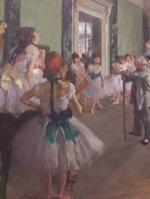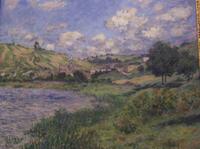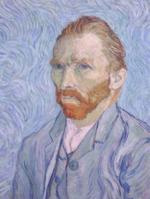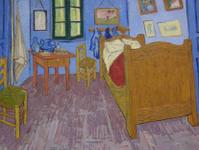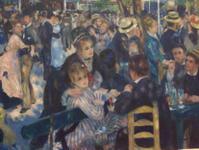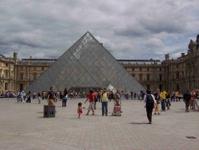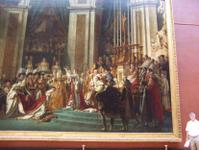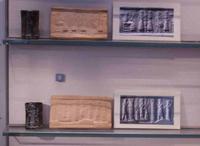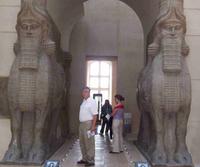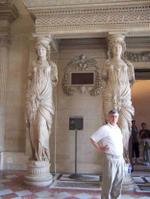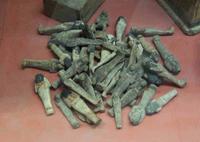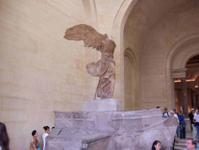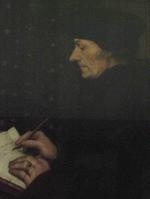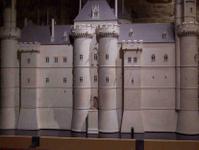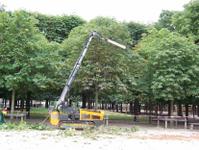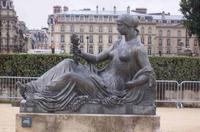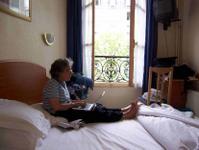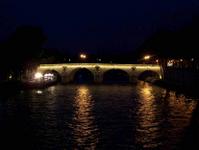Tuesday, July 26, was our last full day in Paris. We got up a bit later as Howard was still suffering from a rash that had gone down to his extremities and itched terribly. Once he left the hotel room, it seemed better, however.
This day was our day to explore the Jewish Quarter and go to the Carnavalet Museum, a French history museum that Rick Steves highly recommended. We were glad we went as we enjoyed it too. It is on the edge of the old Jewish Quarter and only about 5 blocks from our hotel. We got there about 11:30 and stayed 3 hours. We wanted to go through in chronological order, but given the complexity of the 2 mansions that the free museum is housed in, that was impossible. I will describe it in chronological order, however.

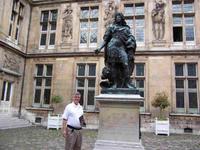
The courtyards were very interesting. In one was a rare pre-revolutionary bronze, a statue of Louis XIV. It is rare because almost all were melted down during the revolution to make weapons. Another huge courtyard had gorgeous gardens.
Off to one side of the museum was a section on ancient Paris with notes on people living there over 4500 years ago (and parts of wooden hulls from ships from that time) and also lots of information on the Roman occupation. They lived on the two islands and the left (south) bank. (We realized it was called the Left Bank because the water was flowing west, and if one stands in the direction of the flow of the water, the south bank is on the left.)
The museum was filled with period pieces of furniture from the 16th century to the 20th century and also paintings that showed life during those times. (We only saw rooms through the 19th century).
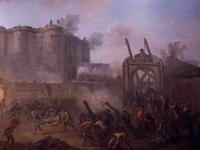 They included several models of the Bastille with its
They included several models of the Bastille with its  100 foot tall
100 foot tall 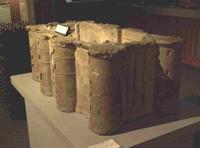 walls and paintings of the Bastille in history and during the early part of the French Revolution when it was burned.
walls and paintings of the Bastille in history and during the early part of the French Revolution when it was burned.We saw pictures of the leaders of the Revolution and I learned more about the craziness of
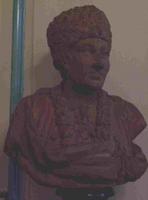 Robespierre who wanted had started to establish a secular religion to replace Catholicism, with all the hoopla. He wanted a state based on "virtue and rule by terror." This is a picture of Marat.
Robespierre who wanted had started to establish a secular religion to replace Catholicism, with all the hoopla. He wanted a state based on "virtue and rule by terror." This is a picture of Marat.There was a smaller David painting from just before the Revolution (of the oath the deputies took) That was to be made into a much larger one but which was never finished. Since photography was not in use at that time, paintings are the best visual records of history from that time. We saw a painting of Guillotine who invented this more modern and less painful way of putting a criminal to death. Howard told me that the king actually gave advice on how to make it better, for example, putting the blade on an angle. The king had gone along with the idea of being a figurehead, hoping that the
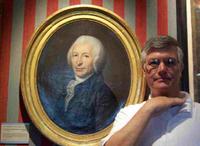 madness that had grabbed the Revolution would blow over, but he ended up being one of the many killed by it. At one time up to 30 a day were decapitated?not royals, but revolutionaries that Robespierre suspected (like MacCarthy). Less than two years after the craziness began, Robespierre was challenged, tried to commit suicide, and eventually died a short time later....ending the mass killings. I found out that before the revolution, the rooster (or gaulle) was the symbol of France.
madness that had grabbed the Revolution would blow over, but he ended up being one of the many killed by it. At one time up to 30 a day were decapitated?not royals, but revolutionaries that Robespierre suspected (like MacCarthy). Less than two years after the craziness began, Robespierre was challenged, tried to commit suicide, and eventually died a short time later....ending the mass killings. I found out that before the revolution, the rooster (or gaulle) was the symbol of France.We saw pictures of Napoleon and of Paris during his rise to power, of Napoleon III (Napoleon's nephew) and of the man he commissioned to remodel the streets of Paris in the mid 1800's. We
 saw paintings of Notre Dame and the Louvre during various centuries, and we saw furniture that reflected the styles of the times of Louis XIV, XV, and XVI.
saw paintings of Notre Dame and the Louvre during various centuries, and we saw furniture that reflected the styles of the times of Louis XIV, XV, and XVI.Howard got two good little books at the bookstore, one, a short history of France and the other a genealogy of the kings of France in detail.
We then used Rick Steves' book to find a delightful, reasonably priced cafe(CafeHugo), and we ate on the sidewalk of the Place de Vosges.. Though this cafe had plenty of outside seating, I?ve been amazed at the places that stick several small tables on the sidewalk, giving less place for people to walk. Howard had an omelet with potatoes and onions (under 5 euros--a euro was $1.21) and I had a Nicoise Salad (tuna, lettuce, tomatoes, olives, hard boiled eggs and a balsamic vinegar dressing, common in Nice but here too for 8,5 euros). We sat away from most of the smokers, but the truck in front of us barred our view of the plaza most of the time.
From there we headed into the Jewish neighborhood. In less than 4 blocks, we saw at least 5 places selling falafel and at least 4 Judaica stores. We went looking in 3 shops for a haggadah in French for a friend, though it is a bit out of season. I talked in Hebrew to the first clerk I met -- his Hebrew he said was better than his English but not as good as my Hebrew). I found out that he usually uses a Hebrew only Haggadah. A number of the ones he had were identical to the ones we sell at Tree of Life Judaica in Seattle (where I work), just in Hebrew and French instead of Hebrew and English. They had all come from Israel. I did find one I didn't recognize, so after going to an ATM to get more money, we came back and bought it. At another store, I bought a small Elle Weisel haggadah that WAS published in France. There I was surprised and delighted to find the DK children's holiday board books in French. It was fun to walk around the neighborhood in search of something and to discover the area. Shopkeepers were not overly friendly...all the stores were run by men, at least when we went in them. Some but not all of the items were the same as what we have in the Seattle store, but they are much more expensive. For instance, the DK board books were at least 9 euros (over $10), where they are under $7 in the US.
From there, we boarded bus #69 to go on a final tour around the parts of town we had
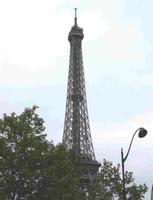 visited....up to the Eifel Tower. Unfortunately, I missed a great opportunity to get a picture of the full tower. We passed by the Louvre, Orsay, Invalid (former HUGE hospital now military museum where Napoleon is buried) and the open area in front of it where expositions had been held), the national military school (Ecole Militair), a big department store, and lots of small shops as we traveled on narrow, one-way roads for the most part. The bus driver was amused that we and another couple (with the same guide book) didn?t get off at the end but wanted to go full circle around...but he didn't charge us to go back.
visited....up to the Eifel Tower. Unfortunately, I missed a great opportunity to get a picture of the full tower. We passed by the Louvre, Orsay, Invalid (former HUGE hospital now military museum where Napoleon is buried) and the open area in front of it where expositions had been held), the national military school (Ecole Militair), a big department store, and lots of small shops as we traveled on narrow, one-way roads for the most part. The bus driver was amused that we and another couple (with the same guide book) didn?t get off at the end but wanted to go full circle around...but he didn't charge us to go back.We got off at Hotel de Ville, to look for a restaurant in the guidebook, but it was closed. After walking more and getting some groceries for the next a.m., Howard went back to our favorite bakery and had a strawberry tart and cafe creme (no longer called cafe au lait) and then we went on to one of the fast-food Chinese eateries when I got a small portion of vegetables and white rice (for 3 euros, less than a large cafe creme). The food is on display, and once you pick out what you want, it is heated (often overheated) in a microwave. We found out that stir fry disher are OK that way, but previously fried or broiled items are not.
By then it was 9, so we headed home to pack and get to bed as we had to get up at 6:30 the next morning to leave and take the subway 2 stops and then the RER 30+ minutes to Charles de Gaulle. It was the end of four nice full days in Paris.

